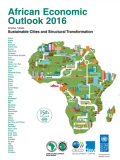
This white paper provides an analysis of the Intended Nationally Determined Contributions (INDCs) for 37 partner countries in the U.S. Government's Enhancing Capacity for Low Emission Development Strategies (EC-LEDS) program and other designated priority countries. The white paper includes an overview of global INDCs, country profiles for countries, regional trends, and sectoral trends. Moreover, each country profile includes information from the INDC on the:

The African Economic Outlook (AEO) 2016 presents the current state of economic and social development in Africa and projects the outlook for the coming two years. The AEO is a product of collaborative work by three international partners: the African Development Bank, the OECD Development Centre and the United Nations Development Programme.
The AEO 2016 shows that the continent is performing well in regard to economic, social and governance issues and has encouraging prospects for the near future. With its special theme on sustainable cities and structural transformation, this edition looks closely at Africa’s distinctive pathways towards urbanisation and at how this is increasingly shifting economic resources towards more productive activities.
Countries in Sub-Saharan Africa (SSA) have experienced dramatic economic growth in the past decade, with six of the ten fastest growing economies in the world found in SSA between 2000 and 2010. Economic growth is critical to continued development and poverty reduction, but can have, as has already become visible in the region, significant environmental costs and can even hinder further long term economic growth and development, if environmentally unsustainable growth paths are continued. However greener growth is needed to allow SSA countries to continue to develop, while avoiding or reducing negative environmental impacts.
This policy brief highlights key findings from the FCFA Zambia pilot case study regarding how current and future climate science can enable development and humanitarian policy, planning and implementation that is climate smart and robust to projected changes in the medium to long term. The findings are based on activities undertaken by the Red Cross/Red Crescent Climate Centre between February and October 2014, in close collaboration with the Met Office Hadley Centre and the Zambia Red Cross Society. These activities included a literature review, scientific research, two multi-sector, multi-stakeholder workshops and a high-level meeting with key representatives from government, civil society, the Met Office and the private sector.
This paper illustrates the foundations of green growth in Zambia and provides an overview of green development co-operation efforts in the country from 2004 to 2012. Furthermore, it discusses on-going efforts towards greening growth in Zambia. Aditionally, the study looks at total bilateral green Official Development Assistance (ODA) flows from members of the Organisation for Economic Co-operation and Development’s (OECD) Development Assistance Committee (DAC) member countries, i.e. targeting biodiversity, climate change adaptation, climate change mitigation, desertification, and other environmental objectives. This analysis draws on OECD DAC statistics, in particular the Creditor 10 Reporting System (CRS). It describes the sectors targeted, as well as the instruments used, and discusses the degree of alignment between Zambian priorities and providers’ activities. Another section of the paper then explores specific provider co-ordination efforts and strategies to support the mainstreaming of green issues incountry. The paper concludes with a number of questions that could guide further research on this topic in Zambia and beyond.
